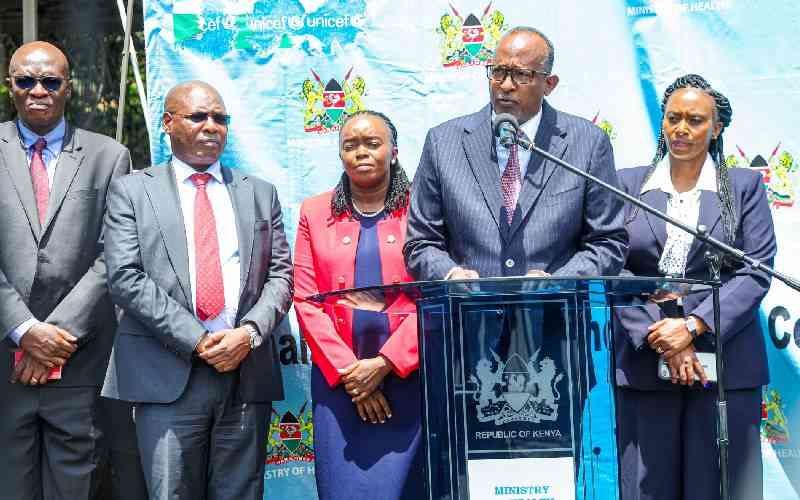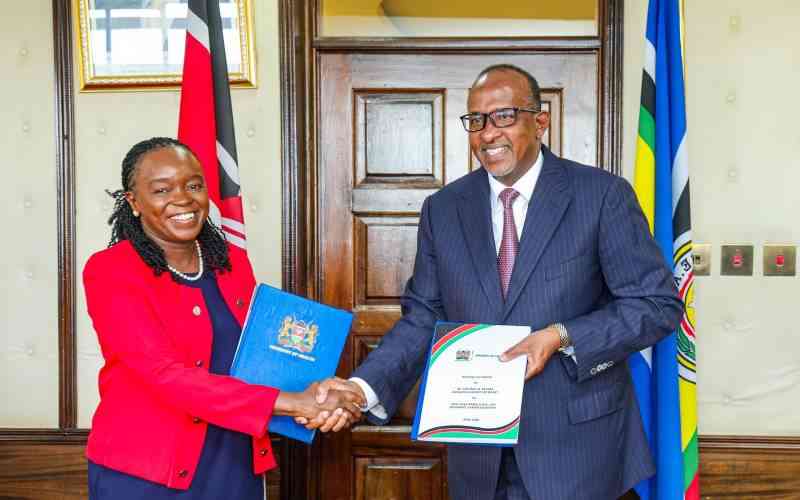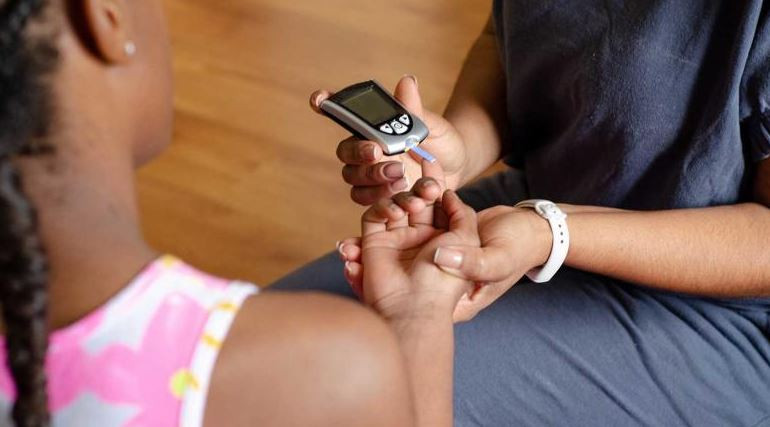
In Kenya, the pain of Endometriosis often goes unnoticed, except by the women who live with it. For as long as she can remember, pain has been a part of Hellen Njeri’s, 28, life. What started as severe cramps during her teenage years evolved into a debilitating condition that has impacted every aspect of her existence.
It’s eight years now since Hellen, a resident of Naivasha and a mother of two, was diagnosed with Endometriosis.
“I remember as if it were yesterday, back in 2017; I started experiencing painful cramps that I had not felt before. I experienced heavy bleeding and swelling in my legs every month during my periods. At the time, I didn’t think much of it, I just assumed it was normal for some one starting their menstrual cycle, unaware that there was more going on beneath the surface,” Hellen begins.
“Its normal for married women to become pregnant, so that same year I gave birth to my second child through Caesarean Section, which felt strange to me since I had given birth to my first born child without any complications. The medical team assisting me that day noticed something was wrong and after some tests, I was diagnosed with Endometriosis, a condition I knew very little about,” she recalls painfully.
According to Dr Sauda Farooqui, an Obstetrician Gynaecologist at The Nairobi West Hospital, Endometriosis is a condition in which endometrial tissue that normally lines the uterus is also found outside of it.
Keep Reading
- Hysterectomy leads to more health risks, new study reveals
- Endometriosis linked to slightly higher risk of early death
- Study links fibroids and endometriosis to higher death risk
- Study links endometriosis and uterine fibroids to premature death risk
“One in 6 to 10 women in Kenya may have Endometriosis; however, investigations are still ongoing. We have specialized centers that primarily focus on the condition, offering both surgical and medical interventions,” observes Dr Farooqui.
Endometriosis affects roughly 10 per cent (190 million) of reproductive-age women and girls globally, according to the World Health Organization (WHO).
In addition, the American Society for Reproductive Medicine found that 24-50 per cent of women suffering from infertility have Endometriosis.
“Painful and heavy periods, prolonged bleeding, painful sex, back pain, painful defecation—especially during menstruation—are major signs associated with this condition,” says Dr Farooqui. “It is important to note that a third of women with Endometriosis may not exhibit any symptoms.”
Little information
“The cause of Endometriosis is that during menstruation, some blood flows backwards from the fallopian tubes into the peritoneal cavity, where it can spread, a process we call seeding. Depending on where the deposits settle, this determine the symptoms. For example, if you have a lesion on your ovary, you may experience cyclical pain during your periods, if there is a lesion on your rectum, you may get pain while passing stool. Some people even have deposits in their naval region and may bleed from there during their periods, Dr Farooqui explains.
What comes next after a diagnosis? These were the questions swirling in Hellens’ mind, leaving her without clear answers. She bravely asked the medical team for solutions and was advised to undergo laparoscopic surgery, after which, she would be medicated and everything would be alright.
“I had very little information about the condition, so out of curiosity, I turned to Google for more insights. Through the knowledge shared by gynecologists, I started to understand it better. When I broke the news to my family, they were shocked to learn I was battling Endometriosis, but they had no choice but to accept it and support me as best as they could,” Hellen explains.
“I went through surgery, medicated and went back home because by then, my condition was still in stage one. I was informed there is no proven cure for this condition and all along, I have been taking drugs - still no notable change as long as my health is concerned.”
According to Hellen, life has not been easy for her since 2017; the condition completely changed her life for worse, though she remains hopeful for recovery. “I have been in and out of the hospital, getting sick repeatedly. The cost of endometriosis medication is high, and I find it hard to afford, even with support from my friends and family. I rely on pain killers because I still struggle with painful bleeding that can last up to seven days along with bloating and indigestion as my main sources of discomfort,” she says.
Hellen, a mother of two spends over Sh30,000 each month to manage this condition. As an unemployed young mother trying to make ends meet, she acknowledges that without her family support, her condition could have severely weakened her.
According to Dr Farooqui, the financial burden of Endometriosis is high because of the medications used to suppress it. “This disease is quite expensive. If a patient has deep Endometriosis, they will need extensive surgery and most of the time this surgery is done laparoscopically which is also known as keyhole surgery and this can prove to be quite expensive. However, not everybody needs surgery.”
Nancy Ngugi, 35, a young mother and a resident of Nakuru has the same experience with Endometriosis.
When Nancy first experienced the searing pain in her lower abdomen, she never imagined it would be the start of of a lifelong battle. Her search for answers led to countless doctors, none of whom could explain why her pain persisted. It wasn’t until years later that she finally learned the truth: she had Endometriosis. Nancy’s journey highlights the silent epidemic of underdiagnosed and misunderstood Endometriosis in Kenya, where women’s pain is often minimized, and the healthcare system struggles to keep pace.
Deliberating pain
According to Dr Farooqui, diagnosing endometriosis is challenging because of the reliance on radiological investigations, which may not always be accurate, especially if the lesions are very small.
However, awareness of the disease has significantly improved leading to earlier diagnosis for more people.
“I was in Class 8 when I started having my periods and I was happy about it; It felt like a rite of passage into womanhood. Little did I know that disappointments would hit me hard later. I kept complaining about the strange and deliberating pain, but I was told it’s normal, preferring me to take warm water and everything would be okay,” Nancy explains.
“The pain was intense every month since I was in Class 8 until I got married in 2016. It’s considered normal to want to have a child soon after getting married, so four years into my marriage, I decided it was the right time to try for a baby. However, issues with infertility arose, leading me to seek further help from medical professionals. I explained everything to the gynaecologist, underwent tests, and was diagnosed with endometriosis. I was confused for a while, as it was something I never expected to face.”
“I was advised to relax, and they promised to treat me until I recovered but deep down, I knew it was a serious condition, I’m a high school teacher, so I was aware of implications. I underwent surgery and was told to return to the hospital every month for injections and checkups. The journey has been not easy at all; the hospital has been my second home, where I find myself camping out now and again,” she painfully recalls.
Nancy like Hellen has been getting enough support from family but she complains of financial difficulties of living with this condition.
“I was told by medical professionals that the only way to manage this condition is through ongoing treatment, which involves taking medications and getting injections regularly. This all comes at a cost, and unfortunately, the management and it can be done through taking drugs and injections now and again which needs money, insurance we have does not provide the support we need. It’s a distressing situation that sometimes leads to overwhelming stress in my life. Endometriosis is accompanied by significant pain, which can make one even question their existence,” Nancy explains.
She typically misses around three days of school each month due to severe pain, a situation her students and colleagues have noticed. This adds to her stress, as some may misinterpret her absences and perceive her as weak, which she finds incredibly frustrating.
“There is a lot of drama associated with Endometriosis. Because of the pain, it can lead women into depression because of lack of proper diagnosis. Many women don’t even know they have the condition, and are often told to simply endure the pain. This can be demoralizing, as they feel they are constantly complaining about something, that no one seems to address,” Dr Farooqui says.
According to Dr Farooqui, Endometriosis can lead to various psychological issues. The impact of the disease largely depends on its location. For example, if a woman has a rectal nodule, may cause painful defecation. If the condition affects the upper vagina, it can lead to painful intercourse, which can significantly impact a woman’s overall sexual health and relationships.”
Subsiding medications
Despite their struggles, Nancy and Hellen remain optimistic and believe that a brighter future lies ahead.
Nancy’s infertility has been addressed, and she holds onto the hope that the pains she endures will eventually subside, allowing her to live a normal life like anyone else in Kenya.
They have a message for the government as advocates for Endometriosis awareness.
“The Government of Kenya is not doing enough to silence this condition. Their focus seems to be on other issues, leaving innocent citizens to suffer. There needs to be more emphasis on subsiding medications and ensuring they are accessible to everyone. We should not fight this battle alone. This is a serious condition for women, but I remain hopeful for a better life,” Nancy asserts.
“My issue is with insurance coverage related to the disease. It has become increasingly difficult to get insurance support for hospital bills, so I urge the government to reconsider this and ensure we have adequate coverage. The Sh6,000 we receive for surgery is simply not enough. As I mentioned earlier, I’m spending Sh30,000 each month, so what does Sh6,000 really amount to in that context? Very unfortunate.”
Raise awareness
Dr Farooqui explains that there are no preventive measures for this disease and that treatment varies from patient to patient.
“This condition often subsides after menopause, so medications that mimic menopause can be beneficial including combined oral contraceptive pills and Visanne (hormonal drug indicated for the treatment of endometriosis). Surgery is also an option,” she says.
She encourages women experiencing painful periods to reject misconception that menstrual pain is normal and to seek out a gynaecologist for a proper assessment to identify the underlying cause.
“In Kenya, there have been recent campaigns to raise awareness, but much more can be done to address this condition. The involvement of social media is crucial,” Dr Farooqui says.
For years, Nancy and Hellen have suffered in silence, enduring what many people and some healthcare providers casually referred to as “bad periods” before finally receiving diagnosis of endometriosis. Their story reflects the silent struggles faced by countless Kenyan women battling this misunderstood condition, against inadequate healthcare and limited awareness.
According to the WHO, treatments for managing endometriosis can vary based on the severity of symptoms and whether pregnancy is desired. There is currently no cure for the disease.
“Non-steroidal anti-inflammatory drugs (NSAIDs) and analgesics like Ibuprofen and Naproxen are commonly used to relieve pain. Hormonal treatments, including GnRH analogues and various contraceptive methods such as hormonal intrauterine devices (IUDs), vaginal rings, implants, can also help control pain.”
“Treatments plans should be tailored to individual preferences and take into account effectiveness, side effects, long-term safety, costs and availability. Raising awareness can help people to be diagnosed early as timely treatment can slow or halt the disease’s progression and reduce the long-term symptoms,” she concludes.





